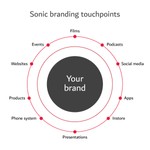When it comes to brand recall our hearing is one of the strongest senses we have. That’s why the use of sound as part of brand building has been around for centuries.
Historically, tower-like minarets were introduced in eighth century Baghdad as platforms to call to prayer, and in medieval Europe church bells were first used for the same purpose. With the rise of radio and then television in the last century, jingles started to be written and linked to commercial brands. Over time, the use of sounds such as Intel’s five-note “Bong” and Microsoft’s start-up “Wave” have become part of broader sonic branding strategies.
A recent IPSOS study that found that advertising with sonic branding consistently see an 8.5 times uplift in branded attention. And sonic branding is even more important if a brand is targeting younger audiences. A recent WPP Group study found that 75% of Gen Z consumers say music makes them feel more connected to a brand. Sonic branding is evolving from a technique used by a limited number of marketers to a must-have asset for brands across sectors. Sonic branding can be defined broadly as the strategic use of sound as a part of a brand’s identity.
Most people think of short sonic logos or mnemonics they hear – the AT&T chimes or the dum-dum Netflix start-up sound. But every piece of branded sound or music makes an impression on target audiences, from advertising and digital interface sounds through to physical environments. Every brand wants to improve its recall, brand attribution and appeal, and sonic branding is great at stimulating specific emotional reactions. Awareness and memorability are obviously important, but in an overcrowded information environment sonic branding can arouse emotions that prompt positive brand associations.
Sound can make a brand more meaningful in people’s lives, so context and cultural impact are everything. Furthermore, ownable sonic assets are much more valuable in the long term for a company and its brands than simply the short-term licensing of a popular song. As a brand’s customer journey evolves, the sonic expression of that brand needs to extend well beyond traditional advertising into social media, apps, podcasts, sponsorships, devices, ringtones, live experiences, voice assistants and beyond. Done right, a sonic identity can enter popular culture and become unforgettable.
While most toothpaste brands focus on functional messaging, Colgate recently partnered with Massive Music to differentiate itself from rivals by launching a sonic identity. Originally founded in Amsterdam in the early 2000s, and now with ten international offices including a recent addition in Dubai, Massive Music’s brief was to find something that was positive, instantly recognizable, and would have global appeal across more than 200 markets. The company carried out extensive research through whitepapers and interviews with academics, ethnomusicologists (yes, that’s a job) and neuroscientists.
The research revealed that the human hum is universally considered optimistic, a key theme that the brand wanted to be associated with. Today, Colgate is a great example of a brand thinking beyond visual cues to connect with consumers on another level, joining the likes of Mastercard, T-Mobile and McDonald’s. The toothpaste’s new sonic identity is a melody comprising female and male voices humming to uplifting backing music. Massive Music created an entire toolkit of versions for multiple Colgate markets and usages — watch how they did it here

